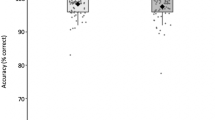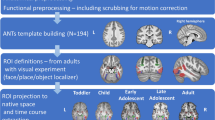Abstract
Using diffusion tensor imaging and tractography, we found that a disruption in structural connectivity in ventral occipito-temporal cortex may be the neurobiological basis for the lifelong impairment in face recognition that is experienced by individuals who suffer from congenital prosopagnosia. Our findings suggest that white-matter fibers in ventral occipito-temporal cortex support the integrated function of a distributed cortical network that subserves normal face processing.
This is a preview of subscription content, access via your institution
Access options
Subscribe to this journal
Receive 12 print issues and online access
$209.00 per year
only $17.42 per issue
Buy this article
- Purchase on Springer Link
- Instant access to full article PDF
Prices may be subject to local taxes which are calculated during checkout


Similar content being viewed by others
References
Behrmann, M. & Avidan, G. Trends Cogn. Sci. 9, 180–187 (2005).
Ishai, A., Schmidt, C.F. & Boesiger, P. Brain Res. Bull. 67, 87–93 (2005).
Minnebusch, D.A., Suchan, B., Ramon, M. & Daum, I. Eur. J. Neurosci. 25, 2234–2247 (2007).
Harris, A.M., Duchaine, B.C. & Nakayama, K. Neuropsychologia 43, 2125–2136 (2005).
Hadjikhani, N. & De Gelder, B. Hum. Brain Mapp. 16, 176–182 (2002).
Avidan, G., Hasson, U., Malach, R. & Behrmann, M. J. Cogn. Neurosci. 17, 1150–1167 (2005).
Hasson, U., Avidan, G., Deouell, L.Y., Bentin, S. & Malach, R. J. Cogn. Neurosci. 15, 419–431 (2003).
Behrmann, M., Avidan, G., Gao, F. & Black, S. Cereb. Cortex 17, 2354–2363 (2007).
Thomas, C. et al. J. Cogn. Neurosci. 20, 268–284 (2008).
Mori, S. et al. Magn. Reson. Med. 47, 215–223 (2002).
Yamasaki, T. et al. J. Neurol. Sci. 221, 53–60 (2004).
Tsao, D.Y., Schweers, N., Moeller, S. & Freiwald, W.A. Nat. Neurosci. 11, 877–879 (2008).
Summerfield, C. et al. Science 314, 1311–1314 (2006).
Bar, M. et al. Proc. Natl. Acad. Sci. USA 103, 449–454 (2006).
Grueter, M. et al. Cortex 43, 734–749 (2007).
Acknowledgements
We are grateful to S. Mori and H. Jiang of Johns Hopkins University who provided advice and guidance at various stages of this project regarding the development of the DTI protocol and method of analysis. We thank S. Kurdilla and D. Viszlay of the Brain Imaging Research Center for their help in the acquisition of the imaging data and B. Frye and T. Keller for their help with the computation and analyses of fractional anisotropy maps. This study was funded by grants from the US National Institute of Mental Health (MH54246) to M.B. and by awards from the National Alliance for Autism Research (Autism Speaks) to C.T. and K.H. and from the Cure Autism Now foundation to K.H.
Author information
Authors and Affiliations
Contributions
C.T conducted the experiment, undertook the majority of the data analysis and wrote the manuscript. G.A. and K.H. assisted with characterizing the subjects and collecting the behavioral data. K.J. and F.G. contributed to data analysis. M.B. contributed to writing the manuscript and supervised the project.
Corresponding author
Supplementary information
Supplementary Text and Figures
Supplementary Figures 1 and 2, Supplementary Table 1 and Supplementary Methods (PDF 436 kb)
Rights and permissions
About this article
Cite this article
Thomas, C., Avidan, G., Humphreys, K. et al. Reduced structural connectivity in ventral visual cortex in congenital prosopagnosia. Nat Neurosci 12, 29–31 (2009). https://doi.org/10.1038/nn.2224
Received:
Accepted:
Published:
Issue Date:
DOI: https://doi.org/10.1038/nn.2224
This article is cited by
-
Individual differences and the multidimensional nature of face perception
Nature Reviews Psychology (2022)
-
Establishing the functional relevancy of white matter connections in the visual system and beyond
Brain Structure and Function (2022)
-
Diffusion tensor imaging point to ongoing functional impairment in HIV-infected children at age 5, undetectable using standard neurodevelopmental assessments
AIDS Research and Therapy (2020)
-
Abnormal brain white matter in patients with hemifacial spasm: a diffusion tensor imaging study
Neuroradiology (2020)
-
Separate lanes for adding and reading in the white matter highways of the human brain
Nature Communications (2019)



